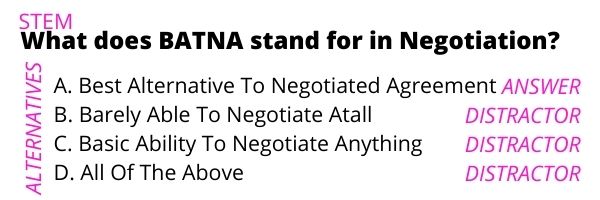If you are interested in assessing Level 2 from the Kirkpatrick learning model, then there is a very good chance you will be using multiple choice tests. By asking multiple choice questions, you are able to assess the learning and retention of material in your sellers, ensuring that they took the necessary information away from any training or enablement initiative.
The challenge is that most multiple choice tests are written badly. Most are so easy that they almost always have a 100% pass rate and offer no challenge to the learner. Others have questions written in such a way that they frustrate the person trying to answer the question to the point where they just give up caring.
If you are going to be designing multiple choice tests to assess salesperson learning and knowledge retention, check out these essential tips as well as key mistakes to avoid.
How To Structure A Multiple Choice Question
First of all, lets define the different parts of a multiple choice question.

- The Stem is the actual question you want to pose.
- Alternatives are all of the options the salesperson can possibly choose.
- The Answer is the correct choice from all the possible alternatives.
- Distractors are all the wrong answers that are present among the options to select.
Stems should be easy to read and clear in the question they are asking. Avoid using negative phrasing to complicate the question. Instead, the question can be made harder by selecting either more challenging alternatives, or by aiming at a different level on Bloom’s Taxonomy (which we will cover shortly).
Alternatives should all be relevant to the question, and should require the person answering to think about each possible response. Too often, as demonstrated in the example above, too little thought is put into writing the alternatives, making the answer too obvious.
Distractors should be closely related to the answer, but should have something definitively wrong about them. Concepts such as ambiguity, justification or personal perspectives should not be possible when selecting a wrong response from a correct answer. There needs to be a specific reason why each of your distractors are wrong that the person answering needs to figure out in order to select the correct answer.
Bloom’s Taxonomy & Multiple Choice Questions
As well as using more challenging distractors, the other way you can make multiple choice questions harder is to aim at different levels of Bloom’s Taxonomy.
Many multiple choice tests only aim to assess knowledge retention, which is the most superficial level of learning in action. If you want to make your questions more challenging, and likely more relevant to the seller’s application of the knowledge, you need to aim at a higher level. Let’s use the Negotiation question from above as the example. An example of a Level 1 question would be:
- What does BATNA stand for?
Comprehension ensures that your seller understands the concepts that were shared, not just in a direct recall scenario, but by checking other ways they could explain a concept. Can the seller recognise the concept from a different perspective, or explain it to someone in their own words. An example of a Level 2 question would be:
- Which of these options is the best description of a BATNA?
Level 3 of Bloom’s Taxonomy requires learners to be able to apply the knowledge and concept in a more practical setting. Being able to apply theoretical knowledge in the sales environment is essential for all sales training programs, so be sure to include some Level 3 questions. Be warned, however, as designing these questions is a lot more challenging than the other 2 levels. An example of a Level 3 question could be:
- Your prospect presents their XYZ BATNA. Based on this, what would be the most appropriate response?
Common Multiple Choice Test Mistakes
Now we have looked at some of the key ideas related to writing multiple choice questions and tests, lets take a look at some of the common mistakes people make when designing questions.
1. Correct Answer Longer Than All Other Answers
If in doubt, choose the longest answer is usually pretty sensible advice. Rather than falling prey to this common mistake, add content to your distractors and concentrate your correct answer into fewer words.
2. All Of The Above With A Clearly Wrong Distractor
In general, you should avoid using “all of the above” responses. However, if you have one possible answer that is clearly wrong, you have just made it easy for me to disregard this distractor. If you only gave four alternatives, your student now has a 50/50 guess for the right answer.
3. Ambiguous And Contentious Answers
How many months have 28 days in them? The answer you want people to give is February, but don’t they all have 28 days in them technically, plus a few more in places? Be sure your answers cannot be misconstrued.
4. Writing The Same Question Twice In A Test
There are only so many different questions you can ask in a test, so the same question can often appear multiple times in a test. Usually it is written differently, such as in the negative, but often just reading that question can provide the answer to another question elsewhere.
5. Not Writing How Many Responses You Expect
If you want people to check multiple boxes, tell them. People quickly get into a pattern of behaviour, so if you asked me to only select one answer for twenty questions and then just one time you want me to select more than one option, please make it clear.
Conclusion
If you follow these guidelines, you will write better multiple-choice questions and tests than most sales training professionals out there. However, if you want to read more into the techniques for writing multiple-choice questions, I find this article to be very useful.
Feel free to share some of your best multiple choice questions in the comments below for us all to learn from.














Leave a Reply